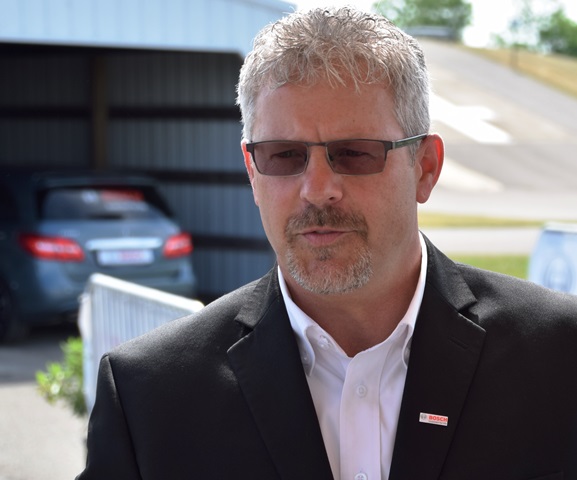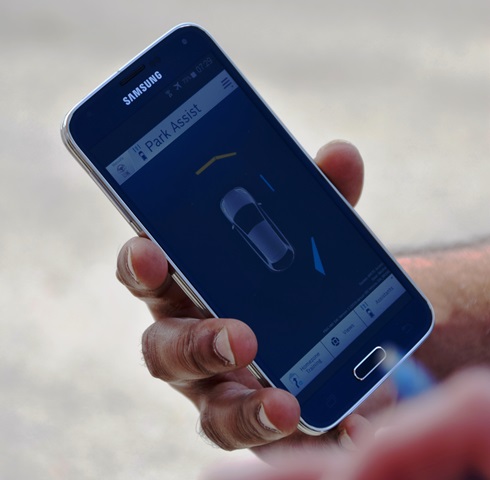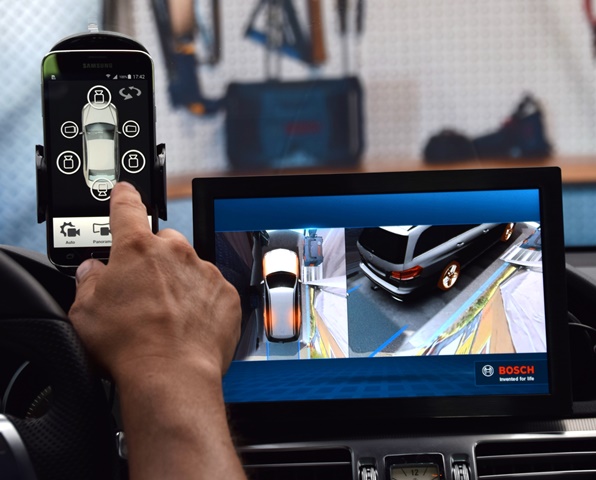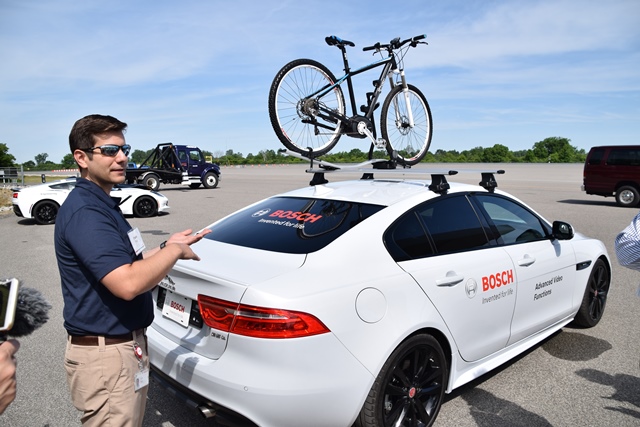FLAT ROCK, MI – Bosch nudges the industry closer to self-driving cars by demonstrating new technologies making a vehicle smart enough to park itself, create a 3D image of its surroundings, brake in emergency situations and stop if cargo strapped on top needs more overhead clearance.
The German supplier sees parking as a low-speed maneuver that few vehicle owners enjoy but represents an ideal testbed for proving out autonomous capabilities.

“Data has shown some consumers are skeptical about fully autonomous vehicles,” Frank Sgambati, director-marketing and product innovation for Bosch Chassis Systems Control North America, says at a media event here to demonstrate several of the technologies.
“There’s (consumer) interest in the technology, but there are some concerns, I think,” he says. “We found 58% (of consumers) very interested and willing to accept technology, but they want the ability to turn it off.”
Advanced driver assistance systems (ADAS), such as lane-departure warning, radar-based adaptive cruise control and automatic emergency braking have the potential to prevent 30% of all crashes, according to research from the Motor & Equipment Manufacturers Assn. and The Boston Consulting Group.
Autonomous technology, coupled with ADAS, could reduce crashes and their associated costs some 90%, the research finds.
A Mercedes B-Class was used to demonstrate Bosch’s Home Zone Park Assist, which employs ultrasonic sensors and a stereo video camera for day-to-day parking in familiar spots, such as a carport or garage. The driver first must park manually, so the vehicle learns the procedure. The camera records the necessary landmarks.
For instance, after grocery shopping, the driver could pull up to the side door of the house for unloading, then use a smartphone app to send the car off (at a top speed of 3 mph [5 km/h]) to park itself in the garage or at the end of the driveway.
“You can even back it into the garage. You can have it turn left, right – it does all those maneuvers,” Nitin Thomas, product manager, says in demonstrating the system while standing outside the car at the Bosch proving grounds here. “As long as you train it, it will replicate what you train it to do.”
However, there are range limitations. A driver can send the vehicle to a programmed destination up to 328 ft. (100 m) away.

The system also can work in parking decks, allowing a driver to exit the vehicle at the building entrance, then use the smartphone app to send the vehicle to a driver-owned spot in the deck, so long as the spot is in range. Home Zone Park Assist also could be helpful if a garage is too crowded to allow a door to swing open.
If the system detects an obstacle, it will stop the car. A secure WiFi connection enables the communication. Bosch plans to have Home Zone Park Assist in production by 2019.
About 13% of auto accidents occur in parking lots, often due to poor visibility, according to Nationwide Insurance claims data.
Cameras, Sensors Form 3D Surround View
Another Bosch system, 3D Surround View, also helps with low-speed parking and maneuvering in complex situations by using four high-resolution mono cameras positioned in the front and rear fascia and both side-view mirrors.
Infiniti is among the automakers today using cameras in those positions to project a bird’s-eye view from above the vehicle onto the vehicle’s display screen.
But Bosch now is stitching those camera views together with information from 12 ultrasonic sensors (four in front, four in rear, two on each side) so a detailed 3D image can be projected on the display screen. The fifth-generation ultrasonic sensors send out short pulses, which are reflected by barriers.

The result is the ability of the driver to select various views around the car with static and dynamic overlays, for instance, when backing out of a tight space or a crowded garage. When parallel parking, the system can prevent expensive alloy rims from scraping the curb.
Sgambati says the system works well in low-light situations, and the auto industry is considering several options for keeping the camera lenses clean.
“There’s a lot of work being done there,” he says. “We’re also working on how to package it and how to create an environment around the lens to minimize dirt and contamination.”
These two parking aids are examples of Level 3 vehicle automation, which is expected to be in use on U.S. roads by 2020.
“In Level 3, the challenges are this interaction between the vehicle and the driver,” Sgambati says. “That’s why from our perspective, driver monitoring or understanding the state of the driver is key. When we get to the self-driving car, in Level 4 and 5, you might not even need to monitor the driver.”
But until that time, Bosch and other companies are focusing intently on the transitions when the driver is in control and hands off to the vehicle, and vice versa.
“We have to keep track of the driver,” Sgambati says. “The vehicle must be able to detect whether the driver is able to take back control of the vehicle.”

Bosch also demonstrates Overhead Clearance Assist with a bike atop a Jaguar XE. The driver measures the height of the bike, then programs that information into the system.
If the vehicle encounters low clearance, such as at a drive-through or parking deck, a stereo camera in front of the vehicle will detect the barrier and sound a warning or could apply the brakes.
The camera can perform multiple functions, also enabling lane keeping and collision avoidance, says Bosch software engineer Frank Riggi.
The system, intended for low-speed situations, has a range of about 33 ft. (10 m).




